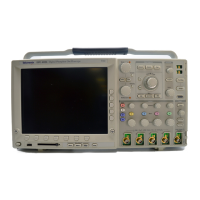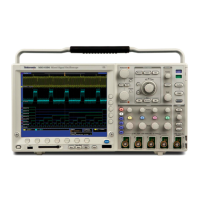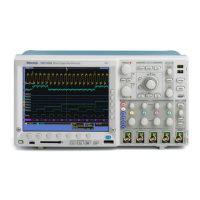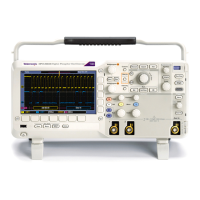Trigger Setup
I
2
C, SPI, CAN, LIN, and FlexRa y Bus Trigger Data Matching
Rolling window b yte m atchin g fo r I
2
C, SPI, and FlexRay. To use a rolling window to trigger on data, you define the
number of bytes to match. Then the oscilloscope uses a rolling window to find any match w ithin a packet, with the windo w rolling
one byte at a time.
For example, if the number of bytes is one, the oscilloscope will attempt to match the first byte , second byte, third , and so
on within the packet.
If the number of bytes is two, the oscilloscope will try to match any two consecutive bytes, such as one and two, two and three,
three and four, and so on. If the oscillosco pe finds a match, it w ill trigger.
With FlexRay, obtain a rolling w indow match by setting the Byte Offset to Don ’t care. Do this by p ressing the front-panel Trigger
button, f ollowed by setting the lower-bezel Type to Bus, Trigger On to Data,pressingData, and ente ring the byte offset with the
side menu and multipurpose knob a..
Specific byte matching (non-rolling window matching for a specific position in the packet) for I
2
C, SPI, CAN, and
FlexRay.
You can trigger on a specificbyteforI
2
C, SPI, CAN, and FlexRay in several ways:
For I
2
C a nd SPI, enter the number of bytes to match t he number of bytes in the signal. Then use don’t care s (X) to mask the
bytes that you are not interested in.
For I
2
C, push the lower-bezel Trigger On to trigger on Address/Data.PushAddress. On the side-bezel menu, push Address,
and rotate multipurpose knobs a and b as needed. Set the address to don’t cares (X) if you want to mask the address. The
data will be matched starting at the first byte without using a rolling window.
For C AN, triggering occurs when the user-selected data input matches the data and qualifier in the signal starting at the first
byte. Set the numb er of bytes to match the number of bytes of interest. Use th e data qualifier to perform: =, !=, <, >, >=,
and <= operations. Triggering on identifier an d data always matches the identifier and data selected by t he user, with the
data starting at the first byte. No rolling window is used.
154 MSO4000 and DPO4000 Series Oscilloscopes User Manual

